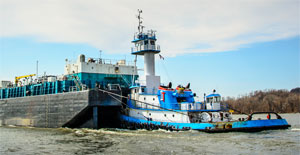By the first week in April, most of the ice had broken up into float ice on the Hudson River, at least south of Kingston, N.Y. Resorting to talking about the weather seemed entirely appropriate aboard the Dann Ocean Towing tug Comet, especially the harsh and unrelenting cold of the 2014-15 winter in the Northeast. As the hard edge of winter eased into spring, the life of mariners plying the coast and inland waterways from Norfolk to Maine eased. Now, it was time for stories.
“It was a bad winter,” said Capt. Perry Felarise, his accent confirming him as a native of La Rose, La. It was a bright, ice-melting day and Felarise was in the upper pilothouse of Comet. The 55-foot height-of-eye afforded him a view over the 80,000-barrel, 332-foot Poling & Cutler barge Eva Leigh Cutler. The 108-foot tug was made up in the notch, light barge, push gear, and headed south. The tow had just made the mouth of Rondout Creek at Kingston.
“You should have been here last week,” said Felarise as he picked the tow through chunk ice surrounding Esopus Meadows Lighthouse. Ahead, on the east bank, the Vanderbilt Mansion overlooked the river where it narrows, chocking the float ice into a tighter mass.
“This is the first day above 50 degrees since December. It was iced up the whole time,” he said. “At night you had to shut down because the buoys are all out of whack and you can’t tell where you’re going. There’s a lot of stress on the tow. We only did daylight towing from Kingston on up to Albany. And it’s only one-way traffic. You have to change your ETA continually.”
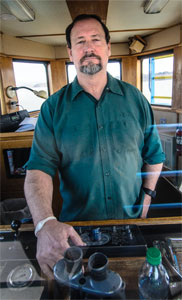 |
|
Capt. Perry Felarise is at the helm of Comet during its voyage downriver from Albany. |
The float ice thinned as the tow ran south. Even the barren winter landscape seemed alive with the hint of spring. “You should see this river in the fall,” said Felarise, referring to the riot of color that the annual leaf die-off presents. Still, the Hudson River Valley — even barren of leaves — is one of the most bucolic landscapes in the country. And with the leaves removed, you can see stately homes overlooking the valley. The tow churned past the Franklin Delano Roosevelt home at Hyde Park off the port beam, then the FDR National Historic Site at Crum Elbow to starboard. Then the town of Poughkeepsie, and then Crown Heights.
Comet is a classic twin-screw, model-bow tug designed by Frank Basile. It was constructed as Clarion in 1977 at Modern Marine Power Inc., a Houma, La., shipyard of which Basile was part owner before he founded Entech & Associates. The 90-year-old Basile recently sold the firm to Kamia Jalili. It is now Entech Designs LLC.
The 108-foot, 4,600-hp Comet is powered by two EMD 12-645-ED7B turbo engines with Reintjes WAV 2600 reduction gears at a 5:1 ratio. The propellers are 116-inch-diameter by 99-inch fixed-pitch five-bladed open wheels.
The tug’s electrical service is provided by two Delco 75-kW generators driven by two 6V-71 Detroit Diesel engines. The towing gear consists of an Intercon 7319 1E 00 towing winch outfitted with 2,000 feet of 2-inch wire wound on the main towing drum, and 2,000 feet of 2-inch wire wound on the secondary towing, or suitcase, drum.
The tow makeup consists of two 72.5-foot soft face lines running back from the stern bitt on the barge and shackled to intermediate wire at the tug’s quarter, then wrapped around sheaves at the stern over to sheaves on the aft deck center line, then forward to the suitcase drum on the Intercon winch. Two-inch-diameter soft safety line is run, port and starboard, from the side bitts on the tug through stern chalks and wrapped on vertical capstans on the stern of the barge.
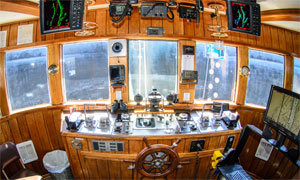 |
|
Comet’s lower wheelhouse is fully equipped, but in this configuration it offers a view of only the notch of the barge. |
There was no ice as the tow churned south, past Pegs Point, New Hamburg and the mouth of Wappinger Creek. Ahead was Danskammer Point and the Newburgh-Beacon Bridge.
Comet’s engine room is a triumph of machinery over space. The two sizable 12-cylinder EMDs and large Reintjes gears anchor a puzzle of wiring, piping, gauges, valves, tanks, drums, toolboxes and all manner of odds and ends. It is the domain of chief engineer George South, an Alabamian from Mobile with the accent to prove it. To a man, the crew commented on South’s attraction to work.
“This is a never-ending job,” he said. “And it’s been a hell of a winter. We got beat up. Even when I got a chance to shut down I’d have to get up every two hours and crank the engines up to keep them from freezing up.” South described how the push wires would freeze up solid and the crew would have to take a Louisville Slugger to them and bust the ice off the lines and the bitts. “We were iced up on the first day of spring,” he said.
South is from the era when marine engineers were at home in an engine room that grew more complex with equipment additions over the years, and he harbors a fondness for EMD propulsion. “Those EMDs, they don’t make them any better,” he declared. “The parts are readily available so you can get them going quickly. I can change out an injector in about 15 minutes from shutdown to startup.”
 |
|
The upper wheelhouse gives the pilot a view of the river. |
This year South was ready for a hard northern winter. “The first year I did this run, I came on in January and it was a nightmare,” he said. “I just wasn’t prepared for it. Now I know what’s coming so I can do what I need to do to prevent problems.”
Since that initial struggle, South has worked out a maintenance program that incorporates preventive measures to combat cold. One is to blow out all of the air lines and valves before winter sets in. He maintains that the procedure has spared him a plethora of problems.
“That first year, every time I turned around there was something freezing up,” South said. “The name of the game is maintenance. If you do your maintenance you don’t have problems. We only have limited dock time where you can shut down to work on something.”
Back in the upper pilothouse, the mate, Ron Sherin, had just made the Newburgh-Beacon Bridge and passed the mouth of Fishkill Creek at Beacon. Then came Cornwall-on-Hudson on the west bank, across from Bannerman Castle on Pollepel Island, now a ruin but originally it was the arsenal of the arms dealer Francis Bannerman.
Sherin is from Anacortes, Wash., but he grew up in Alaska, crab fishing out of Dutch Harbor and dragging for pollock and Pacific cod in the Bering Sea. Bering Sea or no Bering Sea, it was the winter of 2015 on the Hudson River that had stormed to the forefront of his memory.
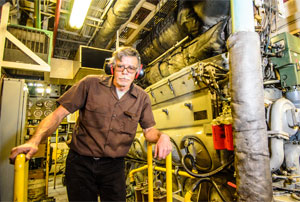 |
|
Comet’s chief engineer, George South, tends to one of the tug’s two EMD 12-645-ED7B main engines. |
“We’ve had ice since late November,” Sherin said as we approached Storm King Point. “We got stuck here at the worst spot, here where it gets narrow. The ice gets to about 3 feet thick and I’ve seen it piled to 4 feet. It started getting real bad about the 10th of January.”
As the tow threaded the Hudson Highlands and passed Storm King Point, it entered a stretch of river that has earned such ominous nicknames as World’s End and Wind Gate. “But the worst spot for ice is off of Storm King Mountain,” said Sherin. “We got stuck at Storm King along with a 14,000-hp ship that couldn’t break the ice at Storm King Point just above West Point.”
Sherin has been stuck in the ice at Storm King several times, a few times up to 12 hours. “We would come out of the notch and break ice around the barge and get back in the notch and try to keep going. We can break about 2 feet of ice. Or the cutter Thunder Bay would come and break us out.” The 140-foot Thunder Bay is a Coast Guard Bay-class icebreaking tug.
Sherin took a break from winter stories to explain that normal anxieties on the Hudson are fog and passing ships. “And in the summer it’s a madhouse with all the recreational boats. The bigger yachts have professional mariners so they’re OK. When I come through World’s End in the summer I’m on the radio solid, and I can’t really do anything.”
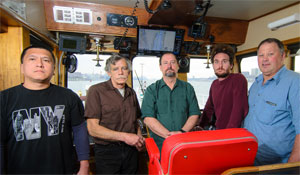 |
|
Comet’s crew on the voyage downriver from Albany to New York City: from left, able seaman Edgar Chua, South, Felarise, Kalimnios and Sherin. |
Approaching the dogleg corner at Gees Point and the ramparts of the U.S. Military Academy, the tow was making 10 knots of headway into a wind blowing 35 knots. Sherin radioed a tow that had just made Jones Point to get the helmsman’s take on wind conditions rounding Gees Point. The other helmsman confirmed that the tow would get hit with a good blast once it cleared the point.
“The point is a blind corner and you can’t see what’s coming,” said Sherin. A headwind added issues, the worst of which would be the wind catching the tow broadside, preventing Sherin from making the corner.
Sherin slowed the engine to 600 rpm to reserve power and turned the barge into the point, rather than into the channel, flanking the tow around until it was pointed into the wind. He then used the reserve power to throttle up the engines to 850 rpm as he made the corner and resumed churning south with the river, rather than being pushed across it.
“I usually speed up to 800 rpm but with this wind I went to 850 because I wanted to make sure there were no issues. This boat has great strength ahead. Good power and the maneuverability without the nozzles is great,” he said.
Sherin explained that Bear Mountain Bridge is a significant calling point to get a sense of the wind conditions at Jones Point, another a blind corner. But by this time Sherin was aware of the strength of the wind and, employing the same flanking procedure as at Gees Point, made Jones Point without an issue.
At the Indian Point Nuclear Power Plant the river widens to 3.4 miles at Haverstraw Bay and Croton-on-Hudson. The tow passed the maximum-security prison, Sing Sing, at Ossining. Ahead, the silhouette of the Tappan Zee Bridge and the crane booms employed to construct its replacement span.
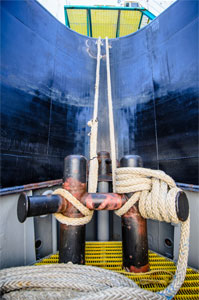 |
|
The crew used this safety line tie-up at the notch involving Comet’s H-bitt with horns. |
In the galley, able seaman John Kalimnios apologized for not having any winter stories. It was his first trip on a tug and he had only been aboard Comet for 20 days, escaping the brunt of the bad weather. He had built up sea time working dive boats at Cape Canaveral, Fla., and was planning to work his way up the staircase on tugs. At the moment, when he was not working on deck, his talents were employed cooking and cleaning.
“I haven’t had to do any chipping and painting yet because everything was iced up. But it’s coming,” Kalimnios said. “I’m learning on the tug as I go. I’m learning a lot from George and I hope to make it to the wheelhouse as soon as possible.”
Felarise came on watch as the tow approached Manhattan Island. Following a briefing from Sherin on events of the past six hours, he conferred with the office regarding their destination and timing. With Yonkers, Harlem and the George Washington Bridge astern, Comet came abreast of the Intrepid Sea, Air & Space Museum at Pier 86 at the foot of West 46th Street. Felarise called Vessel Traffic to announce his position, length of the tow, draft of the tug, make-up — light barge, push gear — and intentions to anchor at Perth Amboy Anchorage.
The tow passed the Statue of Liberty, entered Kill Van Kull, proceeded along Staten Island’s Tugboat Alley to Arthur Kill and anchored at the mouth of the Raritan River. The 100-foot Kimberly Poling, a Poling & Cutler Marine tug, picked up Eva Leigh Cutler and delivered the barge to the Buckeye Raritan Bay refinery.
“We’ll push product around the harbor for a few days and then we’re heading south with the barge for Jacksonville,” said Felarise. “I’m up for my 17 renewal in 2018. I worked on the Gulf and the Caribbean and started up here in the New York City area in 1988. The last real bad winter was in ‘93 that I can remember, where you had one-way traffic from Kingston on up.”

